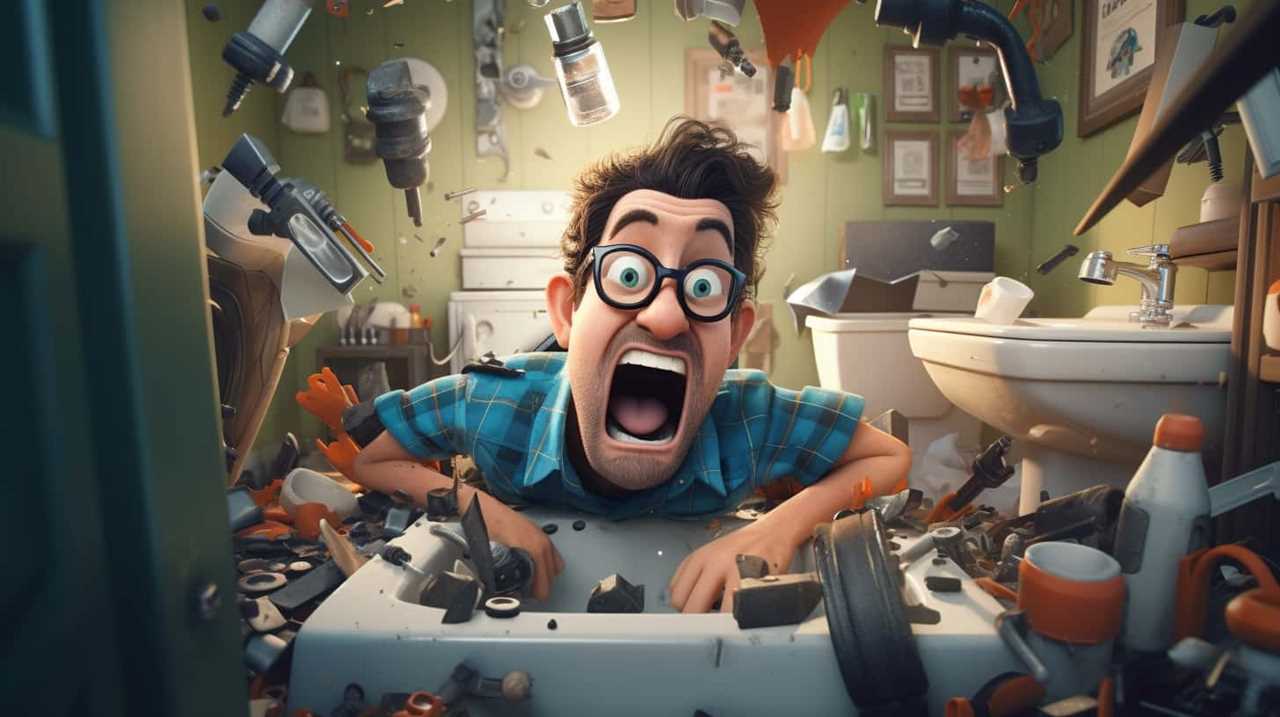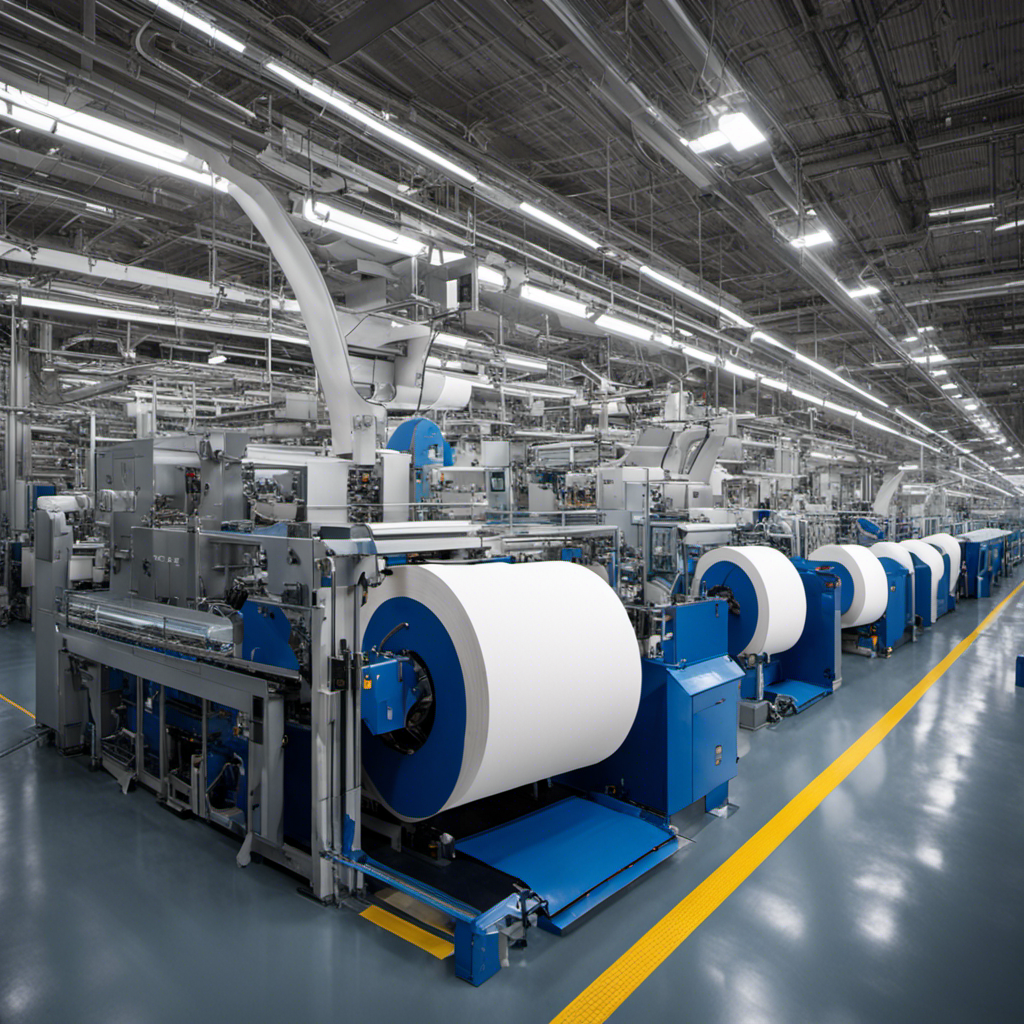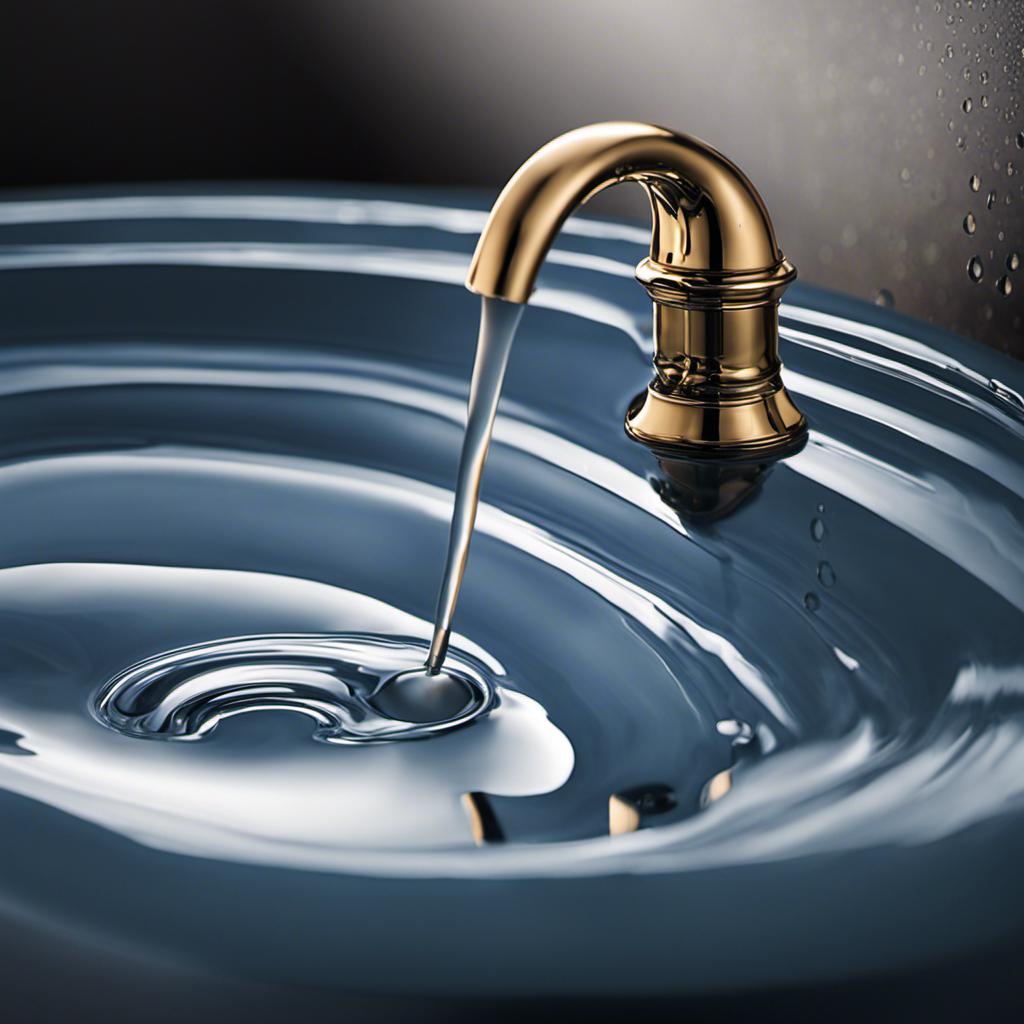Is it advisable to flush a toilet when it’s clogged? This age-old dilemma plagues many of us. In this piece, I will delve into the intricacies of this issue, examining the outcomes, hazards, and other options for addressing a clogged toilet.
Experts will weigh in, and I’ll share some best practices and common mistakes to avoid.
So, if you’re seeking toilet mastery and a functioning throne, stick around and let’s plunge into this topic together.
Key Takeaways
- Flushing a clogged toilet can lead to overflow and water damage.
- Understanding the mechanics of a clogged toilet can help prevent future blockages.
- Effective unclogging techniques include using a plunger and toilet auger.
- Flushing a clogged toilet can result in plumbing damage, health hazards, and contamination.
The Consequences of Flushing a Clogged Toilet
When faced with a clogged toilet, it’s crucial to understand the potential consequences of flushing it. Flushing a clogged toilet can lead to a variety of problems and risks that can cause further damage and inconvenience.

One of the main consequences of flushing a clogged toilet is the risk of overflow. When the toilet is already backed up, flushing it can cause the water and waste to overflow onto the bathroom floor, creating a messy and unsanitary situation. This can result in water damage to the flooring and walls, as well as the potential for mold and mildew growth.
Additionally, flushing a clogged toilet can put excessive strain on the plumbing system, leading to pipe bursts or leaks. This can result in costly repairs and the need for professional assistance.
Moreover, flushing large objects or excessive amounts of toilet paper in a clogged toilet can cause blockages further down the sewer line, potentially affecting the entire plumbing system of the house.
Therefore, it’s important to consider the consequences and risks before flushing a clogged toilet to avoid further complications and expenses.
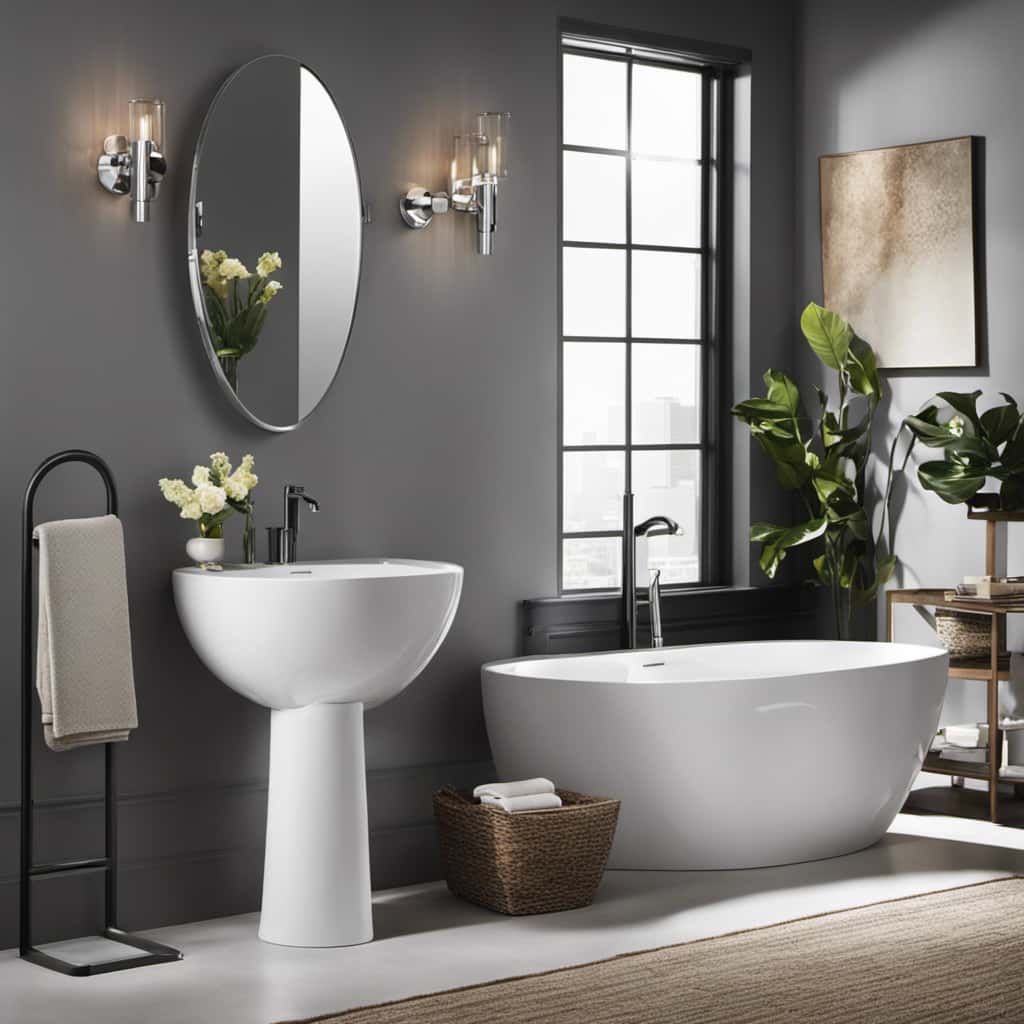
Understanding the Mechanics of a Clogged Toilet
Understanding the mechanics of a clogged toilet is crucial in order to effectively address the issue. There are various causes of clogged toilets, such as excessive toilet paper, foreign objects, or a buildup of waste over time.
To unclog a toilet, there are several techniques and tips that can be employed. These include using a plunger, a toilet auger, or a DIY mixture of hot water and dish soap.
Causes of Clogged Toilets
I can explain the causes of clogged toilets by understanding the mechanics behind them. Here are some common toilet clogging mistakes to be aware of:
- Flushing inappropriate items: Toilets are designed to handle human waste and toilet paper. Flushing items like sanitary products, wipes, or paper towels can lead to blockages.
- Low water flow: Insufficient water flow during flushing can prevent waste from being carried away, causing clogs. This can happen due to low water pressure or a faulty flush valve.
- Pipe obstructions: Over time, mineral deposits, debris, or foreign objects can accumulate in the pipes, obstructing the flow of waste and causing clogs.
- Improper use of plungers: Using a plunger incorrectly, such as not creating a tight seal or using excessive force, can push the clog further down the pipe or damage the toilet.
Understanding these causes can help prevent future toilet blockages and ensure a smoothly functioning bathroom.

Unclogging Techniques and Tips
To effectively unclog a toilet, I rely on a combination of plunging and using a toilet auger. These two methods are the most effective and practical ways to tackle a clogged toilet.
When using a plunger, make sure it has a good seal around the drain and apply firm but controlled pressure. Push down and pull up repeatedly to create suction and dislodge the clog.
If the plunger doesn’t work, it’s time to bring out the toilet auger. This tool is a long flexible cable with a corkscrew-like head that’s inserted into the toilet drain. Rotate the auger handle clockwise to break up and remove the clog.
Remember to avoid using harsh chemicals or other toilet unclogging products as they can damage the plumbing system. Stick to these DIY unclogging methods for a successful outcome.

Risks Involved in Flushing a Clogged Toilet
Now let’s talk about the risks involved in flushing a clogged toilet.
One major risk is the potential for plumbing damage. When you flush a clogged toilet, it can cause the pipes to back up or even burst, leading to costly repairs.
Additionally, there’s also a health hazard involved. Flushing a clogged toilet can cause sewage to overflow, exposing you to harmful bacteria and contaminants.
Plumbing Damage Prevention
One important step in preventing plumbing damage is to avoid flushing a clogged toilet. Flushing a clogged toilet can lead to various risks and potential damage to your plumbing system. Here are some key reasons why you shouldn’t flush a clogged toilet:
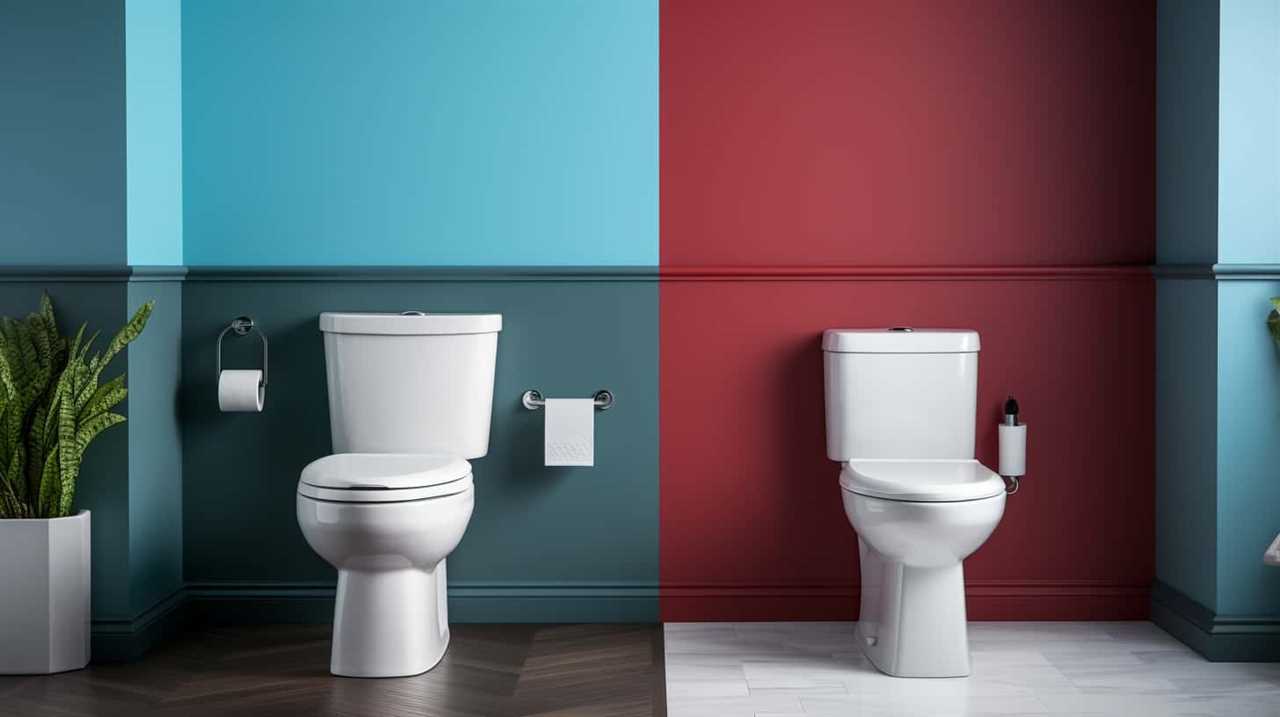
- Increased water pressure: Flushing a clogged toilet can cause a sudden increase in water pressure, which can put strain on your pipes and potentially lead to leaks or burst pipes.
- Backflow: When you flush a clogged toilet, there’s a risk of backflow, where wastewater can flow back into your bathroom or even into other parts of your home, leading to contamination and further damage.
- Clogging the main sewer line: If you flush a severely clogged toilet, it can result in the blockage of your main sewer line, causing wastewater to back up into your home and potentially causing extensive damage.
- Damage to the toilet itself: Flushing a clogged toilet repeatedly can damage the flushing mechanism, the bowl, or the pipes connected to it, leading to costly repairs or replacements.
By avoiding flushing a clogged toilet, you can prevent these risks and maintain the integrity of your plumbing system.
Regular plumbing maintenance and implementing preventive measures for toilet clog prevention are essential to avoid potential damage and costly repairs.
Health Hazards Assessment
There are four main health hazards associated with flushing a clogged toilet. When a toilet is clogged, it can lead to potential health risks and sanitation concerns. Here is an assessment of the risks involved:
| Health Hazard | Description | Prevention |
|---|---|---|
| 1. Bacterial Contamination | Flushing a clogged toilet can cause bacteria and germs to spread in the bathroom, increasing the risk of infections. | Always wash hands thoroughly after handling a clogged toilet and use disinfectants to clean the area. |
| 2. Water Damage | If a clogged toilet overflows, it can cause water damage to the floor, walls, and other structures in the bathroom. | Regularly inspect and maintain the toilet to prevent clogs and address any plumbing issues promptly. |
| 3. Mold Growth | Excess moisture from a clogged toilet can create an ideal environment for mold growth, which can lead to respiratory problems and allergies. | Ensure proper ventilation in the bathroom and promptly address any leaks or water damage. |
| 4. Foul Odors | A clogged toilet can emit unpleasant odors, which can be both unpleasant and unhygienic. | Use air fresheners or odor-absorbing products to minimize odors and address the underlying cause of the clog. |
Understanding these health risks and taking appropriate measures to prevent them is crucial for maintaining a safe and hygienic bathroom environment. Now, let’s explore the signs that indicate your toilet is clogged.

Signs That Indicate Your Toilet Is Clogged
Sometimes, I notice the signs that my toilet is clogged when I see water rising instead of flushing down. It’s important to be aware of these signs so that you can take immediate action to prevent further damage or inconvenience.
Here are some common signs that indicate your toilet is clogged:
- Water rising instead of flushing down: This is the most obvious sign of a clogged toilet. When you flush, the water level should go down, not up. If you notice water rising or overflowing, it’s a clear indication of a clog.
- Slow draining: If you notice that the water is draining slowly after flushing, it could be a sign of a partial clog in the drain pipe. This can happen when debris or waste accumulates over time.
- Gurgling sounds: If you hear gurgling sounds coming from your toilet after flushing, it could indicate a clog. These sounds occur when air is trapped in the pipes due to a blockage.
- Foul odors: A clogged toilet can emit unpleasant odors due to the trapped waste and stagnant water. If you notice a persistent foul smell, it’s a sign that you need to address the clog.
Alternative Methods to Unclog a Toilet
When faced with a clogged toilet, there are alternative methods you can try before resorting to flushing.
The two most common options are using a plunger or a snake. A plunger creates pressure to dislodge the blockage, while a snake physically removes the clog.
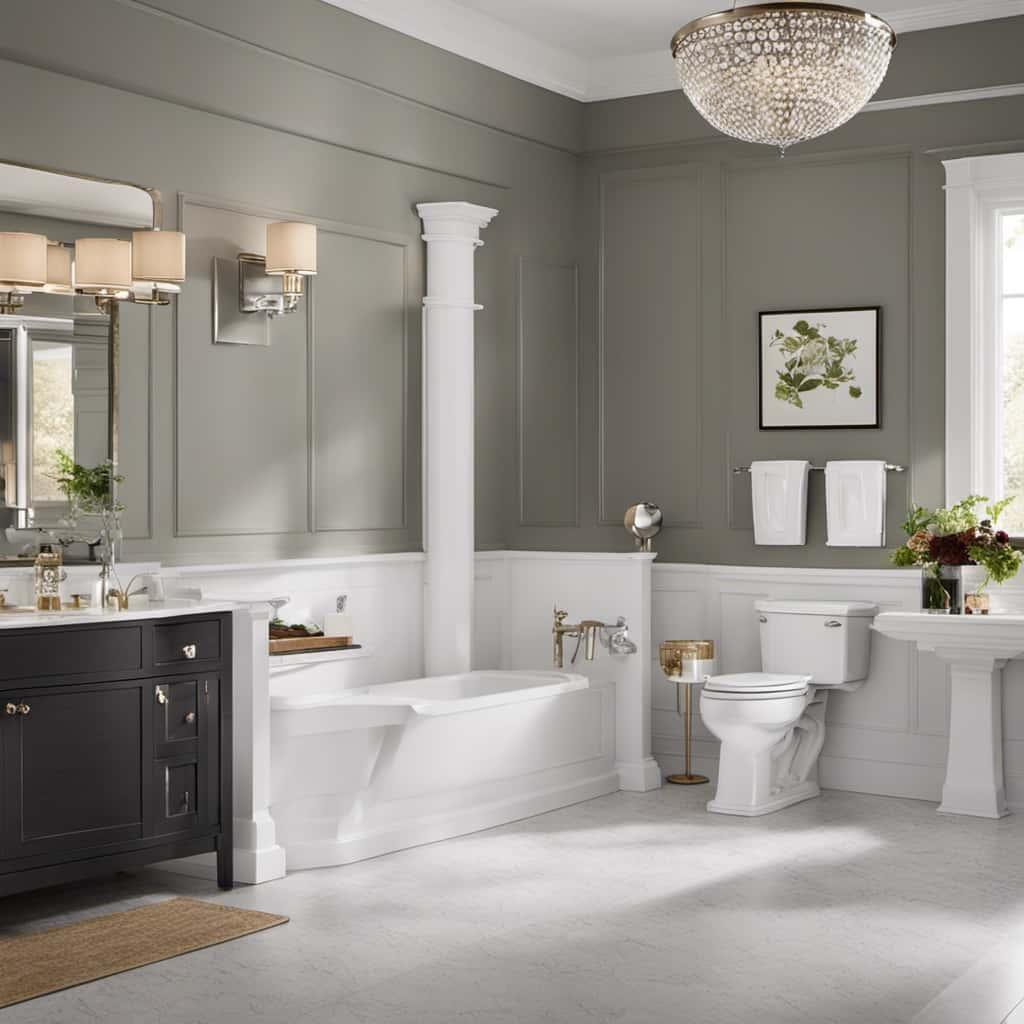
Additionally, there are natural cleaning solutions available that may help break down the obstruction.
Plunger Vs. Snake
One effective alternative method to unclog a toilet is using a plunger. Here are some other plunger alternatives and snake alternatives that you can try:
- Plumbing snake: This tool is long and flexible, allowing it to reach deeper into the drain to break up and remove clogs.
- Baking soda and vinegar: Mix half a cup of baking soda with half a cup of vinegar and pour it into the toilet. Let it sit for a few hours, then flush with hot water.
- Hot water and dish soap: Add a few tablespoons of dish soap to a pot of hot water and pour it into the toilet. Let it sit for a while, then flush.
- Wire coat hanger: Straighten a wire coat hanger and use it to push and break up the clog.
Now that we’ve explored the plunger and snake alternatives, let’s move on to natural cleaning solutions that can help prevent clogs in the first place.
Natural Cleaning Solutions
To effectively unclog a toilet, I find it helpful to utilize natural cleaning solutions as an alternative method. Natural cleaning products and DIY cleaning solutions can be just as effective as commercial cleaners, without the harsh chemicals. Here are some natural cleaning solutions you can try:

| Solution | Ingredients | Instructions |
|---|---|---|
| Baking Soda and Vinegar | 1 cup baking soda, 2 cups vinegar | Pour baking soda into the toilet bowl, followed by vinegar. Let it fizz for a few minutes, then flush with hot water. |
| Hot Water | Boiling water | Pour a pot of boiling water into the toilet bowl. The hot water can help break down the clog and flush it away. |
| Dish Soap and Hot Water | Dish soap, hot water | Squirt a few drops of dish soap into the toilet bowl, then pour in hot water. Let it sit for a few minutes before flushing. |
Using natural cleaning solutions is not only effective but also safer for the environment and your health. However, if these methods don’t work, it’s time to explore other tools and techniques for unclogging a toilet.
Tools and Techniques for Unclogging a Toilet
I can unclog a toilet using a plunger or a toilet auger. When faced with a clogged toilet, it’s important to have the right tools and techniques to tackle the problem effectively.
Here are some options to consider:
- Plunger: A plunger is the most common tool used to unclog toilets. It creates a seal around the drain and allows you to apply pressure to dislodge the clog. Make sure you have a flange plunger specifically designed for toilets.
- Toilet Auger: If the plunger doesn’t work, a toilet auger can be a helpful tool. It consists of a long flexible cable with a crank handle at one end. The cable is inserted into the toilet drain and rotated to break up or retrieve the clog.
- Chemical Drain Cleaners: While they can be effective, it’s important to use caution when using chemical drain cleaners. They contain harsh chemicals that can damage pipes and fixtures if not used correctly. Always follow the instructions and use protective gear when handling these products.
How to Assess the Severity of a Toilet Clog
To properly assess the severity of a toilet clog, it’s important to carefully observe the water level in the bowl.

Start by flushing the toilet and paying attention to how the water drains. If the water level rises significantly or overflows, it indicates a severe clog. In such cases, avoid flushing the toilet again as it can cause further damage and flooding. Instead, focus on troubleshooting the clogged toilet.
If the water level in the bowl is normal after flushing, but the water drains slowly, it suggests a moderate clog. This can usually be resolved using a plunger or a toilet auger. Begin by using a plunger to create suction and dislodge the clog. If that doesn’t work, try using a toilet auger to break up the obstruction and clear the drain.
On the other hand, if the water level is low or there’s no water at all in the bowl, it indicates a minor or partial clog. In such cases, you can try pouring hot water into the bowl to dissolve the clog. Alternatively, using a plumbing snake or a wire hanger can help dislodge the obstruction.
Factors to Consider Before Deciding to Flush a Clogged Toilet
Before deciding whether or not to flush a clogged toilet, it’s important to take certain factors into consideration. When faced with a plumbing emergency or a DIY toilet repair, these factors can help you make an informed decision on the best course of action.

Here are some key factors to consider:
- Severity of the clog: Assess how severe the clog is. Is it a minor blockage that can be easily resolved with a plunger, or is it a more serious issue that may require professional assistance?
- Water level in the toilet bowl: Take note of the water level in the toilet bowl. If the water level is close to overflowing, it’s best to avoid flushing to prevent any potential flooding or water damage.
- Presence of foreign objects: Determine if there are any foreign objects in the toilet bowl that may be causing the clog. Flushing the toilet in this case could worsen the situation or damage the plumbing system.
- Previous attempts to unclog: Consider any previous attempts you’ve made to unclog the toilet. If you’ve already tried using a plunger or other DIY methods without success, it may be time to seek professional help.
Experts’ Opinions on Flushing a Clogged Toilet
After considering the factors, experts generally advise against flushing a clogged toilet. While it may be tempting to try and clear the blockage with a flush, doing so can pose various risks and potentially worsen the situation. Let’s take a look at what the experts recommend when faced with a clogged toilet.
| Risks of Flushing | Experts’ Recommendations |
|---|---|
| 1. Overflowing water can cause damage to your bathroom floor and surrounding areas. | 1. Use a plunger to gently try and dislodge the blockage. Apply steady pressure and repeat as needed. |
| 2. Flushing a clogged toilet can lead to sewage backup, resulting in costly repairs. | 2. If the plunger doesn’t work, consider using a toilet auger or snake to break up the obstruction. Follow the manufacturer’s instructions carefully. |
| 3. Excessive force from flushing can damage the internal components of the toilet, leading to further issues. | 3. If the blockage persists, it is best to call a professional plumber who has the expertise and tools to safely resolve the problem. |
| 4. Flushing certain objects, such as paper towels or feminine hygiene products, can cause blockages in the plumbing system. | 4. To prevent future clogs, only flush toilet paper and waste. Dispose of other items properly in the trash. |
Best Practices for Preventing Toilet Clogs
One effective way to prevent toilet clogs is by practicing proper waste disposal habits. By following these best practices for preventing blockages, you can ensure that your toilet stays in good condition and functions properly:
- Use toilet paper sparingly: Excessive use of toilet paper can easily lead to clogs. Remember to use only as much as necessary to avoid overburdening the plumbing system.
- Avoid flushing non-flushable items: Items such as wet wipes, sanitary products, and diapers should never be flushed down the toilet. Dispose of them in the trash instead.
- Regularly clean the toilet: Build-up of mineral deposits and other debris can contribute to clogs. Clean the toilet bowl and jet holes regularly to prevent blockages.
- Be mindful of what goes down the drain: Hair, dental floss, and other small objects can accumulate in the pipes and cause clogs. Dispose of them properly to maintain a clear drainage system.
Following these simple guidelines won’t only help prevent toilet clogs but also contribute to overall toilet maintenance. By being proactive in practicing good waste disposal habits, you can avoid the inconvenience and costly repairs associated with clogged toilets.

Common Mistakes to Avoid When Dealing With a Clogged Toilet
To effectively handle a clogged toilet, the first mistake to avoid is trying to forcefully flush it multiple times. This can worsen the problem and potentially lead to overflow, causing more damage and mess. Instead, it’s important to perform a quick risk assessment before taking any action. Assess the severity of the clog and determine if it can be resolved using basic DIY solutions.
One common mistake is using excessive force when plunging. While plunging can be an effective method to unclog a toilet, it should be done with caution. Applying too much force can cause the water to splash out or damage the toilet bowl. It’s crucial to use steady and controlled movements when plunging to avoid any mishaps.
Another mistake to avoid is using harsh chemicals without proper knowledge and precautions. Chemical drain cleaners may seem like an easy fix, but they can be dangerous to both you and the plumbing system if not used correctly. They can cause damage to pipes and fixtures and may even emit toxic fumes. It’s advisable to explore safer and more environmentally-friendly alternatives before resorting to chemical solutions.
Tips for Maintaining a Healthy and Functioning Toilet
To maintain a healthy and functioning toilet, I recommend regularly cleaning and inspecting the plumbing system. Here are some tips for effective toilet maintenance and cleaning:

- Clean the bowl: Use a toilet brush and a mild cleaning solution to scrub the inside of the bowl. Pay special attention to the rim and under the toilet seat.
- Check for leaks: Periodically inspect the toilet for any signs of leaks, such as water pooling around the base or a continuously running toilet. Addressing leaks promptly can prevent water damage and save you money on your water bill.
- Avoid using harsh chemicals: While it may be tempting to use strong chemicals to clean your toilet, they can damage the plumbing and harm the environment. Instead, opt for natural cleaning agents like vinegar and baking soda.
- Maintain the flushing mechanism: Regularly check the flushing mechanism, including the flapper and fill valve, to ensure they’re working properly. Replace any worn-out parts as needed to maintain efficient flushing and prevent clogs.
Frequently Asked Questions
Is It Safe to Use Chemicals to Unclog a Toilet?
Using chemicals to unclog a toilet can be effective but it’s important to consider safety and environmental impact. Safety precautions should be taken when handling chemicals, such as wearing gloves and goggles, and ensuring proper ventilation.
Additionally, chemicals can have negative effects on the environment, especially if they end up in the water supply. It’s worth exploring alternative methods, like using a plunger or a toilet auger, before resorting to chemicals.
What Are Some Common Signs of a Clogged Toilet?
When it comes to a clogged toilet, there are some common signs that can help you determine if it’s clogged.
One of the most obvious signs is when the water level in the bowl rises higher than normal after flushing.

You may also notice that the water drains slowly or not at all.
Another indication is when the toilet makes gurgling sounds or bubbles up when you flush.
These signs can help you identify if your toilet is clogged and needs attention.
Are There Any Alternative Methods to Unclog a Toilet Without Using a Plunger?
When facing a clogged toilet, it’s important to consider alternatives to unclog it without a plunger.

One effective method I’ve used is a combination of hot water and dish soap. I pour a generous amount of dish soap into the toilet bowl, followed by hot water (not boiling).
The soap helps to break down the clog, while the hot water provides additional force to push it through.
It’s a natural and effective home remedy for toilet clog prevention.
How Can I Prevent Toilet Clogs From Happening in the First Place?
To prevent toilet clogs and maintain a healthy toilet, there are a few simple steps you can take.
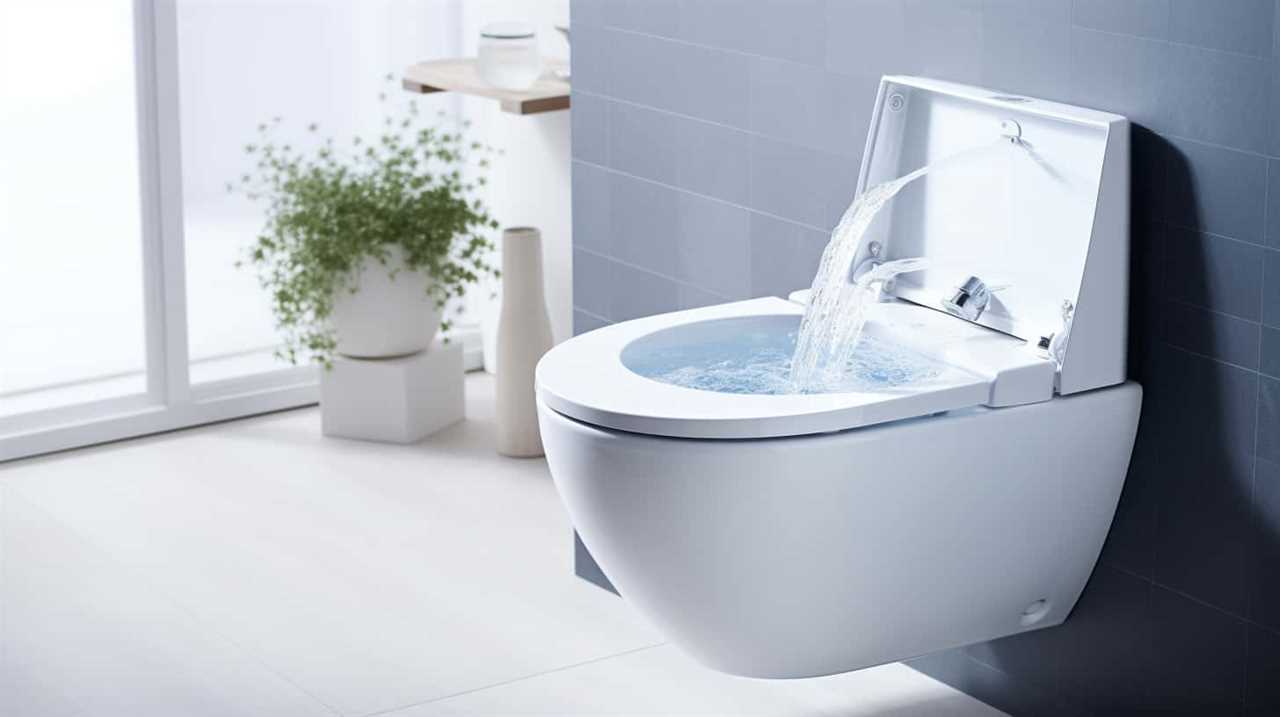
First, be mindful of what you flush down the toilet – avoid flushing large amounts of toilet paper or any non-flushable items.
Second, regularly clean your toilet and check for any signs of blockages.
Lastly, make sure to flush the toilet after each use, as it helps maintain proper water flow and prevents clogs from building up.
What Should I Do if the Clog in My Toilet Is Severe and I Cannot Unclog It Myself?
If the toilet clog is severe and I can’t unclog it myself, I should consider calling a professional for help.

There are many toilet clog solutions that a professional can use to quickly and effectively unclog the toilet.
It’s important not to flush the toilet if it’s clogged, as this could cause more damage and make the problem worse.
Instead, it’s best to leave it to the experts who have the tools and expertise to handle the situation.
Conclusion
In conclusion, it isn’t advisable to flush a clogged toilet as it can lead to serious consequences such as overflowing and water damage. Understanding the mechanics of a clogged toilet and recognizing the signs of a clog can help prevent further issues.

Instead of flushing, it’s recommended to use alternative methods or seek professional help. Remember the old adage, ‘An ounce of prevention is worth a pound of cure,’ and practice good toilet maintenance to avoid clogs in the first place.
